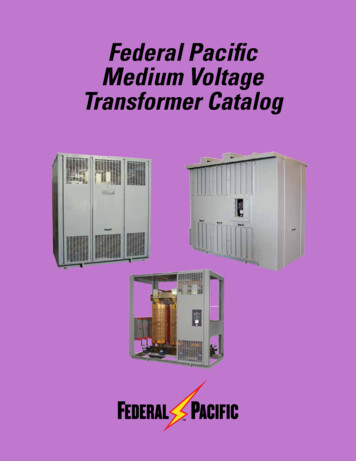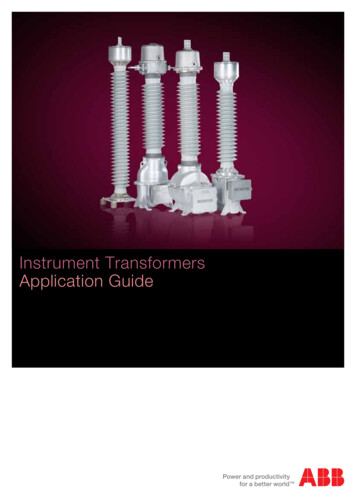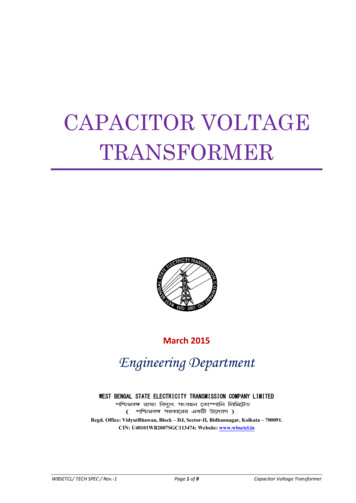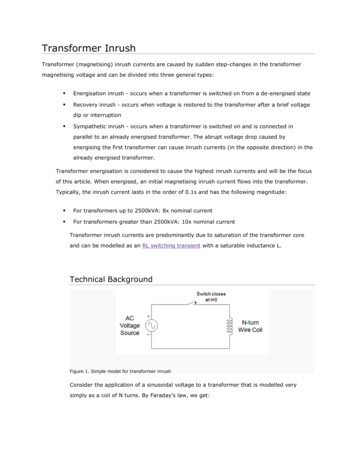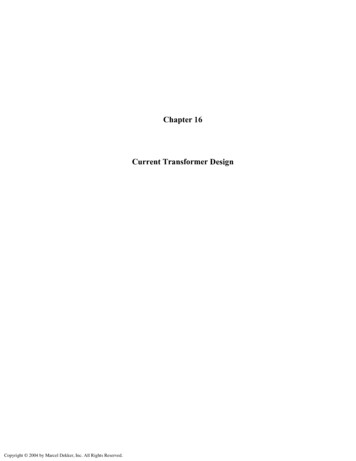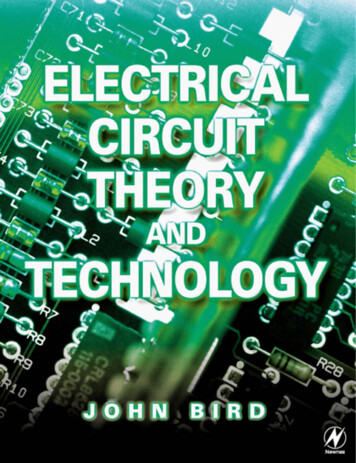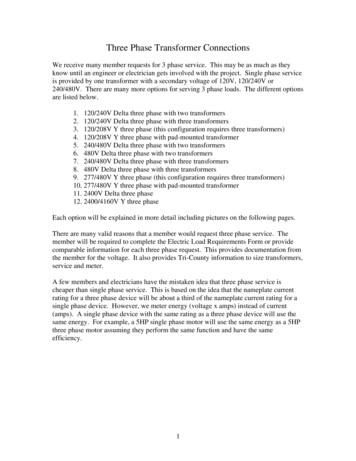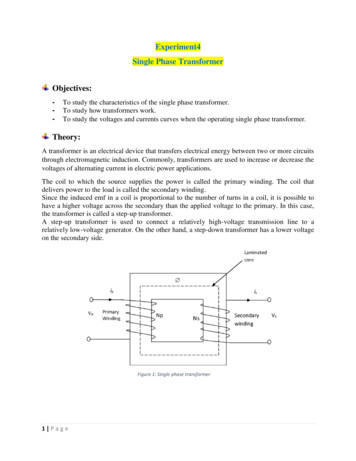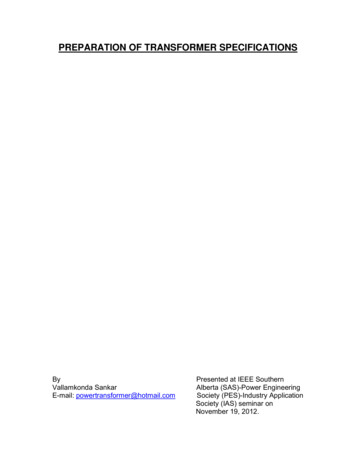
Transcription
PREPARATION OF TRANSFORMER SPECIFICATIONSByVallamkonda SankarE-mail: powertransformer@hotmail.comPresented at IEEE SouthernAlberta (SAS)-Power EngineeringSociety (PES)-Industry ApplicationSociety (IAS) seminar onNovember 19, 2012.
-2-OBJECTIVES To prepare specifications for procuring reliable transformers at market prices. To prepare clear and concise specifications with no ambiguities. To guide users in determining the transformer parameters. To ensure that the transformer parameters meet system needs. To use existing standards to the full extent in the specifications. To familiarize users as to how specifications affect the design and the cost. To encourage the manufacturers to submit cost effective alternates with low losses,meeting all the system needs. To understand the dangers when the transformers are used different to what is statedin the specifications. To discuss the advantages and disadvantages of invited tendering verses opentendering. To know and understand the clarifications/confirmations to ask in the Tender Reviewand Design Review meetings. To avoid delays in delivery by following up with the manufacturer at critical intervals. To check the quality of the transformer by inspecting at correct production stages. To ensure that the factory tests meet system conditions and the standards. To identify the importance of transportation, installation and maintenance whenevaluating tenders. To obtain the best benefits by knowing the characteristics and the costs of thematerials and the components used in the transformers. To interact with transformer manufacturers for mutual benefits. To initiate new or evolving innovations in transformer design and manufacturefor the reduction of cost without compromising the performance.
-3-FUNCTIONS OF TECHNICAL SPECIFICATIONS1. “From an User perspective: To formally and fairly communicate exactly what theContractor has to deliver.” [1]2. “From a Contractor perspective: To be able to accurately offer services andproducts which provide a satisfactory solution (technical and commercial) touser; while remaining a long-term profitable business.” [1]3. “For both User and Contractor: To avoid relationship mishaps associated withcostly variation work.” [1]4. Enable the manufacturer’s design engineers to understand the characteristics ofthe user’s system and how the transformers are operated in service.5. Create an opportunity for manufacturers to apply improved design andmanufacturing methods beneficial to users. Also an opportunity to use advancedmaterials and accessories.6. Many users are of the opinion that they are procuring the lowest costtransformers by ordering based on the lowest evaluated cost bid. Effectivespecifications will help procure transformers with the lowest life cycle cost.7. Technical specifications provide the user a future record of designparameters to which a particular transformer was purchased. This informationis essential for users when a specific transformer has to be moved to adifferent location with different system needs or when a mature system’scontingency plans change. New requirements evolve over time. Pastspecifications may not have considered modern criteria such as:(i) GIC (Geometrically Induced Currents) requirements.(ii) Free buckling requirements on inner coils.(iii) Advanced on-line monitoring devices.(iv) Vacuum type on-load tap changers.(v) SFRA requirements.(vi) Apparent charge (pC).(vii) Impact of secondary generation, especially on transformers with dualsecondaries.Thorough specifications are the first step in establishing long term reliability oftransformers. Specifications should cover the present and future system requirements.Transformers are reliable and offer trouble free service if they are operated as stated inthe specifications and maintained to minimize aging of the insulation. Specificationsshould encourage new developments that increase efficiency while reducing the lifecycle cost. Constructive participation of users in tender review, design review,inspections and resolving conflicts will enhance the long term reliability of thetransformers.CEATI (Canadian Electrical Association Technical Institute) has published a report on‘Review and summary of key standards and guides for station-class power transformers’[18]. This is a good reference while preparing the specifications.Input from maintenance engineers, operating engineers and the manufacturer’s designengineers is essential in preparing effective specifications.
-4-TOPICS1. Ratings.2. Standards.3. Single phase verses three phase.4. Winding connections.5. Vector group.6. Insulation levels.7. Terminals.8. Accessories.9. Types of cooling.10. Sound levels.11. Taps (range, locations etc.).12. Types of taps.13. Impedance.14. Capitalization of losses.15. Short-circuit withstand.16. Special requirements (altitude, over excitation, GIC etc.).17. Overloads.18. Parallel operation.19. Rating plate.20. Alternatives.21. Interesting clauses in the specifications.22. Globalization.23. Data sheets.24. Tests.25. Tender and design review meetings.26. Transportation and limiting dimensions/weights.27. Conclusions.
-5-RATINGSThe transformer’s MV.A rating is usually determined based on the system expected loadgrowth, available generation and expected rate of return on the investment. Thebusiness plan is based on capital cost recovery, depreciation rate and the profit to bemade each year. Transformer applications such as two winding, autotransformer, stepup or step-down etc. influence the transformer rating. Other factors such as expectedpower demand growth and load factor have a large influence in determining thetransformer rating.CSA-C88-M90 clause 4.1 defines the rating as follows. “the rated load in MV.A togetherwith any other assigned characteristics, such as voltage, current, and frequencyassigned by the manufacturer. It shall be regarded as a test rating that defines anoutput that can be taken from the apparatus under prescribed conditions of test, andwithin the limitations of this standard”. Further, ‘Basis of MV.A’ is defined in section 7.2.IEEE standard C57.12.80-2010 clause 3.355 states the rating as follows:- “The rating ofa transformer consists of a volt-ampere output together with any other characteristics,such as voltage, current, frequency, power factor, and temperature rise, assigned to it bythe manufacturer. It is regarded as a rating associated with an output that can be takenfrom the transformer conditions and limitations of established standards”.IEEE standard C57.12.00-2010 clause 5.4.1 describes the rating as follows. “The ratedKV.A of a transformer shall be the output that can be delivered for the time specified atrated secondary voltage and rated frequency without exceeding the specifiedtemperature-rise limitations under prescribed conditions of test, and within the limits ofestablished standards”.IEC 60076-1, 2000 clause 4.1 states the rating as follows:- “The interpretation of ratedpower according to this sub-clause implies that it is a value of apparent power input tothe transformer. This is different from the method used on US tradition (ANSI/IEEEC57.12.00), where ‘rated KV.A’ is ‘the output that can be delivered at rated secondaryvoltage ’ According to that method, allowance for voltage drop has to be made in thedesign so that the necessary primary voltage can be applied to the transformer”.If transformers are purchased per IEEE standard, the electrical location of the taps (inHV, in LV, in series winding, in common winding etc.), application of the taps (for inputvoltage fluctuations or for output voltage regulation), and whether the transformers areoperated as step-down or for step-up determine different MV.A ratings for the input andoutput circuits (HV and LV). Considering this, some users make the calculationsthemselves and specify the currents for each winding. This is preferred since if left to themanufacturers, each manufacturer could calculate the currents differently.Many users have standardized the transformer MV.A ratings used in their systems. Thisis based on overall economy (resulting in fewer spare transformers) and the flexibility ofmoving the transformers to different stations in their system. Site location andtransportation limitations can limit the MV.A rating of the transformer.Input and output (HV and LV) voltage ratings are determined by the economics of powertransmission based on the total MV.A to be transported, length of transmission lines etc.
-6-STANDARDSMany specifications list a number of transformer standards and make a statement in thespecifications that the transformers must meet these standards. Some definitions andrequirements of these standards, such as CSA-C88-M90, IEEE C57.12.00 and IEC60076 are different. The following have different explanations in these standards: Normal or usual service conditions.Rated power.Over voltage conditions.Overload capacity at low ambient temperature.Suggested impedances.Tests and test levels.Dimensions and insulation levels of bushings. Also, the external clearances.Oil temperature rise.Types of taps.Tap range.Tolerances on impedance, losses and magnetization current.The specifications should state which clause in the specification should meet whichstandard. The specifications should also reference the latest version of the standard.When the specifications are not clear, most of the manufacturers bid the transformerswith least first cost. Often these assumptions may not meet system needs. Someexamples are: RCBN taps when system requirement is FCBN taps, in-feed from TV isnot considered when there is in-feed from TV in the system etc.Before quoting a clause from a standard in the specifications, the users must ensure thestandards satisfy their needs. Some users specify that certain parameters should be perindustry standard. There is no ambiguity if the specifications give the reference to thisindustry standard. Users should know that there are no universal “industry standards”and there are only standards such as CSA, IEEE and IEC.Users should be aware of the latest revisions in the standards and also the currentdiscussions in the committees that write the standards. A few of such topics in IEEEtransformers committee are given below. Rating of stabilizing winding (buried tertiary). Correlation of winding temperature indicator (WTI) time constant to the type of coolingand the winding time constant. Partial discharge measurement in pico coulombs rather than micro volts. Sound level test based on sound intensity rather than sound pressure.CSA-C88-M90 was published in 1990 and was reaffirmed in 2009 but was not updated.Normally IEEE and IEC standards are updated or revised at least once in ten years. InIEEE, the Transformers Committee Working Groups are assigned for continuousimprovement of C57.12.00 and C57.12.90 standards. When specifying the transformersper CSA-C88-M90 users should make the necessary updates to their specifications.Standards do not, by themselves, form specifications. The use of the standards correctlywill enable procurement of economical transformers meeting system requirements.
-7-SINGLE-PHASE VERSES THREE-PHASEDimensional and weight limitations at site, transportation restrictions, economics ofspares and transformer reliability primarily determine whether the transformer required issingle-phase or three-phase. A bank of three single-phase transformers cost about 1½times the cost of a three-phase transformer having the same total MV.A.Single-phase transformers may be specified for hydraulic stations because of transportrestrictions and space limitations at site. At large nuclear stations, the risk assessmentgenerally requires the use of single-phase GSU transformers. To replace a failed singlephase transformer takes much less time than a three-phase transformer, reducing downtime to the system and saving considerable cost. Very high voltage transformers(765KV, 1200KV etc.) are single-phase because it is not practical to achieve therequired air clearances in a three phase-transformer. For overall economic reasons,most sub-stations up to 500KV use three-phase transformers.When an old single-phase transformer fails, it is often replaced with a new single-phasetransformer. For a functionally identical new transformer, losses, weight and dimensionsare often much lower than those of the old transformer. This is due to improvements inmaterials, accurate design analysis with advanced mathematics, computers and bettermanufacturing methods. Users should consider these factors, and if it is economical andfeasible (existing foundations, space limitation, etc.), then they should replace the oldsingle-phase transformers with a new three-phase transformer rather than buyinganother single-phase transformer.When the user desires an identical replacement transformer, all the parameters of theold transformer must be given to the bidders. If users do not have the data on the oldtransformers, a pre-tender meeting with the bidders could help.The following will help in writing specifications for a single phase transformer to replacea failed unit in a three-phase bank.1. Neutral bushing current rating is based on where the neutral connection is made(between the units or in the station bus).2. Tertiary bushings current rating is based on where the delta connection is made(between the units or in the station bus).3. Type of transformer core (three-limbs with coils on one limb, or two limbs withcoils on both limbs, or four-limbs with coils on two-limbs) is preferred to be thesame as the remaining two healthy units.4. LTCs to have same run-through positions (this simplifies the control scheme).5. Check with breaker supplier as to whether the capacitance to ground should bethe same on all the units (limit on fault current interruption duty).6. Check whether the two healthy units have subtractive or additive polarity. Preferto order subtractive polarity per present standards. If required, specify properinsulation levels (fully insulated) to use for replacement.7. Stabilizing winding (buried tertiary) must be designed for the faults on the tertiary(this is not required on three phase transformers).8. To avoid undesired circulating current in the tertiary delta, the voltage for thetertiary must be same for all the units. If the tertiary voltage on the two healthyunits is 33.1KV, then specify 33.1KV and not 33KV.
-8-WINDING CONNECTIONSThree phase transformers have windings connected in wye, delta or zig-zag inside thetank. These connections for single phase transformers are made outside the tanks.When a neutral is required then, it is economical to choose a wye or a zig-zag. If aneutral is required on a delta side, then a grounding transformer is needed.Neutrals usually have a lower insulation level compared to the lines. Such windings canbe economically designed with graded insulation. To reduce no-load loss and endclearances to the core; other factors permitting, such windings can be designed ascenter-fed windings. Compared to the taps in delta, taps at neutral result additional costsavings in the tap changers, tank size, oil quantity etc.When both HV and LV are wye connected, a stabilizing winding (buried tertiary) may beneeded for suppression of third harmonics and for neutral stabilization. The determiningfactors are based on the type of core (core type transformers with three-phase threelimbed cores does not require a stabilizing winding, but some users specify a stabilizingwinding), the system and the neutral connection in the system. This often leads to achoice to have one of the main windings delta connected. Protection costs should beconsidered in determining whether the HV or the LV should be delta connected.In certain cases when the LTC is electrically connected to the low voltage winding(considering that the voltage of this winding is not high), it can be considerably cheaperto use delta connection for the low voltage winding. A delta connected winding has alower current by 3 and this could avoid the use of a series transformer to reduce thecurrent in LTC. However, this has some disadvantages. If the insulation level of thiswinding is high, then the cost advantage could be lost. As well, very few three-phaseLTCs for delta connections are available. Instead, three single-phase LTCs are to beused. In such a case, shifting the LTC on to the wye-connected HV needs to beexplored. Based on how the transformer is operated, this could make the transformer avariable flux design.By connecting the windings in wye/zig-zag rather in wye/delta, the need for a groundingtransformer on the delta can be eliminated. Often in a wye/zig-zag transformer, it iseconomical to limit the single line to ground fault current to not exceed the three-phasefault current, by connecting a neutral grounding reactor of suitable reactance in the zigzag neutral. Without the grounding reactor, single line to ground fault currents in awye/zig-zag transformer will be high compared to that of wye/delta transformer with thesame parameters (same MV.A and positive sequence impedance). A wye/zig-zagtransformer costs about 6% more than a wye/delta transformer. In general, a wye/zigzag transformer with a grounding reactor costs less compared to a wye/delta transformerwith a grounding transformer. As it is difficult and costly to have taps on a zig-zagwinding; the taps are normally on the wye winding. In a step-down transformer when thezig-zag winding is the output winding, users prefer to have taps on the zig-zag winding.This is because; taps on the input winding to compensate for regulation will make thetransformer a variable flux unit. Disadvantages of the variable flux taps are discussedunder “Types of Taps”.Users should be aware that when there is no delta in the transformer (wye/wye orwye/zig-zag) the harmonics will flow in to the system. A method to prevent theharmonics flowing in to the system is discussed under Vector Group.
-9-VECTOR GROUPCSA-C88-M90 clause 4.1 states as follows: “Angular displacement (of a polyphasetransformer)--the time angle, expressed in degrees, between the line-to-neutral voltageof the reference identified high-voltage terminal (H1) and the line-to-neutral voltage ofthe corresponding identified low-voltage terminal (X1). Note: The preferred connectionsfor polyphase transformers are those which result in the smallest possible phase-angledisplacement measured in a clockwise direction from the line-to-neutral voltage of thereference identified high-voltage terminal (H1). Thus, standard three-phase transformershave angular displacements of either zero or 30º Clock system (of phase displacement)--a method expressing the phase displacement between two windings by analogy to thehands of a clock.”Many standards and text books show multiple vector group connections. The sameangle shift between HV and LV can be achieved by various vector groups. One o’clockvector can be achieved by the Yd1, Dy1 or Yz1 groups. Twelve o’clock vector can beachieved by the Yy0, Dd0 or Dz0. Vector group has to be carefully selected because ithas a bearing on transformer cost and on the system operation. This is because, eachvector group has a different zero sequence impedance, resulting in different faultcurrents.Only certain types of cores are recommended for the wye/wye connection. The book‘Transformer Engineering’ by L.F. Blume states the following on wye/wye connection [2].“Y-Y connected transformers, excepting three phase three legged core type units, arenot capable of supplying an appreciable single-phase load from line to neutral, owing tothe fact that the corresponding primary currents of such loads, flowing through theprimaries of the unloaded phases, magnetize them. This statement is true for Y-Yconnected single-phase units and shell-type three-phase units. Core-type units however,may, on account of the interlocking of the magnetic fluxes in the three legs, givetolerably good results under conditions of single-phase loads from line to neutral orunbalanced electrostatic charging currents. Y-Y connection with grounded neutral insingle-phase and shell-type three-phase units is dangerous on account of the possibilityof resonance in the third harmonic with the line capacitance. It should never be used”.In a delta/delta connected transformer, a neutral for grounding is not available. Whentwo LVs are required, some users are specifying wye/zig-zag/zig-zag. Users shouldconsider specifying wye/delta/zig-zag (Hoeppner transformer). In these transformers aneutral is available. Since there is a delta, the third harmonics will stay in the transformerand do not flow in to the system.When line voltage is high and the current is small, then connecting this winding in wye iseconomical compared to connecting in delta. This is because the phase voltage (linevoltage/ 3). When the line voltage is small and the current is large, then to connect thiswinding in delta is economical. This is because phase current (line current/ 3). Usersshould consider system costs, system requirements and discuss with transformermanufacturers before stating in the specifications which side should be delta, which sideshould be wye, and the vector group.
-10-INSULATION LEVELSCSA-C88-M90 clause 4.1 defines Lightning Impulse Level as follows: “the prescribedpeak value of the lightning-impulse withstands voltage (full wave). Note: The lightningimpulse level (LIL) has been commonly referred to as the ‘BIL’.”Below are more definitions from CSA-C88-M90 clause 4.1.Switching impulse level (SIL) - the prescribed peak value of the switching impulsewithstands voltage (full wave).Uniform insulation (of a transformer winding) - the insulation of a transformer windingwhen all its ends connected to terminals have the same power frequency withstandvoltage.Nonuniform insulation (of a transformer winding) - the insulation of a transformer windingwhen it has an end intended for direct or indirect connection to ground and is designedwith a lower insulation level assigned to this ground or neutral winding end.Insulation levels should be based on insulation coordination of the system. Standardsgive different insulation levels (BIL levels) for the same system voltage. One example isfor 245KV; CSA-C88-M90 gives four different BIL levels 650KV, 750KV, 850KV and950KV. For 230KV IEEE C57.12.00-2010 gives four different BIL levels 650KV, 750KV,825KV and 900KV. Some consultants who write specifications for users often specifyhigher BIL levels than needed. These consultants say that by specifying higher BILlevels they are helping their clients to procure better transformers. Insulation levels (BILlevels) have a large impact on transformer cost and the losses. As such, it isrecommended that the users to specify only the needed BIL levels, and not to overspecify them.Some users feel that more reliable transformers can be purchased by specifying higherBIL level for the bushings than the windings. Since the bushing is the first component tosee the impulse, some users specify one or two higher BIL level for the bushings thanwhat is actually needed. In such transformers, windings could fail before the bushings,because the BIL level of the bushings is higher than the windings. This is very costlybecause compared to the cost of the winding; the cost of the bushing is small. Also, toreplace the windings is costly and time consuming compared to the bushings.Many techniques (interleaved, counter shield turns etc.) to uniformly distribute theimpulse voltage in the windings have been developed and all the transformermanufacturers are using them successfully. Also manufacturers have reliable computerprograms to calculate the impulse voltage distribution in the windings. As such, there isno need to over specify the BIL levels for windings.Since requests for quotes are ‘free’, some users ask for alternate quotes fortransformers with different BIL levels. One example is for 500KV units where threealternate quotes were requested. The first one was 1425KV BIL for windings and1425KV BIL for bushings. The second alternate was 1425KV BIL for windings and1800KV BIL for bushings. The third alternate was 1800KV for windings and 1800KV forbushings.
-11-INSULATION LEVELS (continued)Often not enough time is given to prepare the tenders. The designer of the transformermanufacturer has to make two separate designs with different BIL levels for windingsand three separate outline drawings to cover all the alternates. In such cases, if notenough time is given there is a possibility that the tenders may not be exactly what isneeded by the user. Preparation of tenders is a significant cost to the manufacturers.Even for house repairs (plumbing, heating, air conditioning repairs, etc.) the contractorsoften charge to give estimates. If the users were to pay at least for the alternatives tocover a part of the cost incurred by the manufacturers, then users will get economicaltenders meeting their system requirements. As in house repair work, customers neednot pay this cost to the successful bidder.Lightning arrestors design has improved to give better protection; so, many standards nolonger require chopped wave tests during impulse tests. Front of wave testingrequirements have also been eliminated by almost all of the standards. Users shoulddiscuss this with their insulation coordination engineers and protection engineers beforespecifying a chopped wave test or a front of wave test and they should be specified onlyif needed by the system. Some users specify a RW-FW-CW-FW impulse test sequencebecause in their experience this sequence enables easier failure detection.Some users compare physical clearance distances between windings, between windingsand ground to evaluate different bids. Some users use these clearances for initialcomparison of the bids; and in the final evaluation, the stresses in oil and in solidinsulation are compared. Comparison of the total distances is not an effective practicesince this does not correctly determine the voltage stresses in oil and in solid insulation.The more appropriate practice is specifying separately the stress limits in oil and in solidinsulation for power frequency, switching surge and impulse voltages. Somespecifications have stated these limits. There are many ways to design the insulationsystem to control these stresses.Some specifications specify more tests, higher test levels and stricter tolerances thanthose stated in the standards. Lower costs can be attained by not deviating from thestandards unless it is specifically needed by the system.Some users specify the BIL of the HV neutral to be the same as the line terminal eventhough the neutral will be solidly grounded in operation. This will significantly increasecost. The cost will be further increased if there an LTC in the HV neutral.Certain types of circuit breakers (SF6 and vacuum interrupters) or when switchingcertain types of loads (solid state loads), can produce a much steeper voltage wave thanwhat is specified in the standards. Transformers can fail (failures had occurred due topart winding resonance, high voltage stresses in the winding etc.) if the windings are notdesigned for these voltage waves. If the breaker is going to produce a different waveshape than what is specified in the standards then the wave shape to which thetransformer should be designed and tested must be clearly stated in the specifications.Based on system needs, if the user wants the impulse test connections to be differentfrom those stated in the standards then it must be stipulated in their specifications. Oneexample is when HV line is impulse tested on an autotransformer, whether the LV linemust be solidly grounded or grounded through impedance.
-12-TERMINALSFollowing definitions are from CSA-C88-M90 clause 4.1:Terminal--conducting element intended for connecting a winding to external conductor.Line terminal--a terminal for connection to a phase conductor of a system.Neutral terminal--(a) for polyphase transformers and polyphase banks of single-phasetransformers, terminal (s) connected to the neutral point of a star-connected or zigzagconnected winding and (b) for single-phase transformers, the terminal intended forconnection to a neutral point of a system.Following definition is from C57.12.80-2010 clause 3.449:Terminal--(A) A conducting element of equipment or a circuit intended for connection toan external conductor. (B) A device attached to a conductor to facilitate connection withanother conductor.In the specifications users should specify all the electrical characteristics and physicaldetails of the terminals. A few are listed below.1. Type of bushings (condenser type, bulk oil type etc.).2. Insulation level of line and neutral bushings.3. Overvoltage.4. Overloads.5. Type of terminal (oil-to-air, oil-to-oil, oil-to-SF6 etc.).6. Oil preservation system (conservator, nitrogen pressurized etc.).7. List of CTs and characteristics to determine ground shield length of the bushings.8. Cover-mounted or horizontally-mounted on the side wall.9. Location (C57.12.10-2010 clause 5.1 indicates the segments).10. Terminal arrangement and markings (Ref: C57.12.10-2010 clause 5.2 Figure 3).11. Standards to which to comply (CSA/EEMAC or IEEE/ANSI or IEC)12. Neutral bushing current rating (same or half of line current).13. Special details (Bus-duct or any other special requirements).14. Connection (bottom-connected or draw-lead/rod).15. Requirement of Doble connectors and bus connectors.16. Creepage length.17. Requirement of cap tap and/or potential tap.18. Porcelain or composite bushings.19. Bushings terminals heights from the transformer base, spacing etc.20. Minimum external clearances (line to line and line to neutral) if non-standard.21. Interchangeability with existing spares or with bushings of another standard.22. Order of bushings arrangement (H1, H2, H3 or H3, H2, H1 etc.) if non-standa
(765KV, 1200KV etc.) are single-phase because it is not practical to achieve the required air clearances in a three phase-transformer. For overall economic reasons, most sub-stations up to 500KV use three-phase transformers. When an old single-phase transformer fails, it is often replaced with a new

